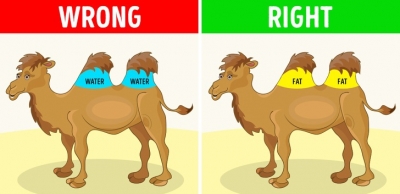Do camels store water in their humps?

Every part of a camel’s body is suitable for life in the desert – from padded feet to blood cells to the hump.
Myth
The idea of the hump as a reservoir of water is not true. It’s rather a mound of fat which gives the camel energy to sustain itself when it has to go for days or weeks without food. The fact that the fat converts into water during metabolism may have given rise to this myth. But it does not help in ‘supplying’ water to the camel. So, where do camels store water? In the bloodstream.
Reality
An adult camel can drink up to 135 litres of water at one go. Much of it is stored in its blood. The corpuscles serve as a water tank from which the camel draws water every day. A bellyful of water can help a camel live for 17 days without a refill. The red blood cells of a camel are football-shaped and much smaller than the circular red blood cells of most animals. These cells aid in continued circulation even when the camel is dehydrated and also allow gulping of such a vast quantity of water at one go. Their anatomical and physiological features are such that they can survive in extreme conditions. Their urine and faeces contain very little water. While most animals lose water while breathing, camels have an efficient respiratory system. Their nostrils trap moisture in their breath before it is exhaled. This moisture is then returned to their body fluids. Camels do not sweat and thereby conserve water. When they need water, their body will first get it from all fluid parts, before going for the water reserves in the bloodstream. This allows their blood to continue to flow normally, even when they are relatively dehydrated.
So, what is the purpose of the hump? Having a hump of fat, instead of fat evenly distributed throughout their bodies, allows for better heat dissipation. It helps keep their body temperature down. If the camel goes for long without food, the hump will collapse and droop. It will take the camel a maximum of four months of proper eating for the hump to get back to normal. Did you know Bactrian camels that inhabit Central Asia have two humps?
Picture Credit : Google
Comments
No comments